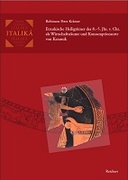Explore

Etruskische Heiligtümer des 8.–5. Jhs. v. Chr. als Wirtschaftsräume und Konsumptionsorte von Keramik
0 Ungluers have
Faved this Work
Login to Fave
While many aspects of Etruscan religion are intensively discussed and studied through current conferences, publications and fieldwork, general research and an overview of the socio-political and economic significance of the religious sphere in Etruscan society is still lacking. This volume examines the economic roles and functions of sanctuaries, as well as their pottery assemblages and vase inscriptions, in the Etruscan heartland during the 8th–5th cent. BCE. The investigation of the Etruscan sacred economy is performed on the basis of three main research questions: the reconstruction of pottery consumption patterns, the identification of production and crafts embedded into sacred contexts, and finally the analysis of the Etruscan sacred landscape as an indicator of socio-political structures and processes.
This book is included in DOAB.
Why read this book? Have your say.
You must be logged in to comment.
Rights Information
Are you the author or publisher of this work? If so, you can claim it as yours by registering as an Unglue.it rights holder.Downloads
This work has been downloaded 73 times via unglue.it ebook links.
- 73 - pdf (CC BY-NC-ND) at OAPEN Library.
Keywords
- Ancient History
- Archaeology
- ceramics, economy
- Classical Archaeology
- Etruscan
- Europe
- Geographical Qualifiers
- Italy
- Society
- Society & Social Sciences
- Southern Europe
- thema EDItEUR::1 Place qualifiers::1D Europe::1DS Southern Europe::1DST Italy
- thema EDItEUR::J Society and Social Sciences
Links
DOI: 10.29091/9783954905836Editions

